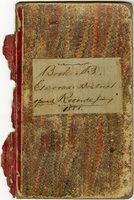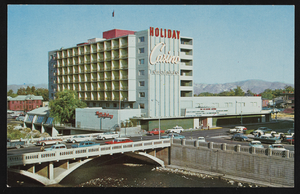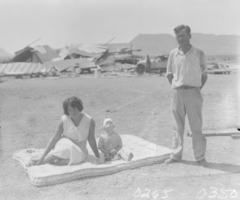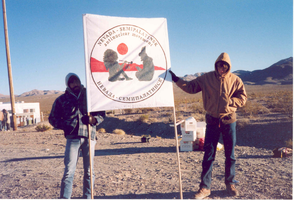Search the Special Collections and Archives Portal
Search Results

Film transparency of a ghost town, Delamar, Nevada, 1956
Date
1956
Archival Collection
Description
A view of some of the abandonded buildings in Delamar, Nevada, taken from a nearby hill. Delamar, Nevada, nicknamed The Widowmaker, is a ghost town in central eastern Nevada, USA along the east side of the Delamar Valley. During its heyday, primarily between 1895 and 1900, it produced $13.5 million in gold. In 1889, prospectors John Ferguson and Joseph Sharp discovered gold around Monkeywrench Wash. A mining camp was then born west of the Monkeywrench Mine. It was called Ferguson. In April 1894, Captain Joseph Raphael De Lamar bought most of the important mines in the area and renamed the Ferguson camp as Delamar. In the same year, a newspaper called the Delamar Lode began publication and a post office was opened. Soon, the new settlement boasted more than 1,500 residents, a hospital, an opera house, churches, a school, several businesses and saloons. Most buildings were made of native rock. By 1896, the Delamar mill was handling up to 260 tons of ore daily. Water for the camp was pumped from a well in Meadow Valley Wash, some twelve miles away. Supplies and materials traveled even further, by mule team over mountainous terrain from the railroad head at Milford, Utah, which was 150 miles from Delamar. Silicosis The gold in the Delamar mines was embedded in quartzite which when crushed created a fine dust. Miners breathing the dust often developed silicosis and the town became known as a "widow-maker." Many ruins now stand semi-intact in the Delamar ghost town region. Foundations can easily be seen from adjacent hills. There are two graveyards, which have been vandalized. The area is honeycombed with mines and mineshafts, but in recent years the main shaft has been blasted closed. Wild horses roam the area. The nearby dry lake is known to pilots as Texas Lake because its outline resembles the state of Texas.
Image

Film transparency of a ghost town, Delamar, Nevada, 1956
Date
1956
Archival Collection
Description
Some of the abandonded buildings in Delamar, Nevada. A tailing pile from one of the mines is visible in the center of the photograph. A stone structure is visible on the right side of the photograph. Delamar, Nevada, nicknamed The Widowmaker, is a ghost town in central eastern Nevada, USA along the east side of the Delamar Valley. During its heyday, primarily between 1895 and 1900, it produced $13.5 million in gold. In 1889, prospectors John Ferguson and Joseph Sharp discovered gold around Monkeywrench Wash. A mining camp was then born west of the Monkeywrench Mine. It was called Ferguson. In April 1894, Captain Joseph Raphael De Lamar bought most of the important mines in the area and renamed the Ferguson camp as Delamar. In the same year, a newspaper called the Delamar Lode began publication and a post office was opened. Soon, the new settlement boasted more than 1,500 residents, a hospital, an opera house, churches, a school, several businesses and saloons. Most buildings were made of native rock. By 1896, the Delamar mill was handling up to 260 tons of ore daily. Water for the camp was pumped from a well in Meadow Valley Wash, some twelve miles away. Supplies and materials traveled even further, by mule team over mountainous terrain from the railroad head at Milford, Utah, which was 150 miles from Delamar. Silicosis The gold in the Delamar mines was embedded in quartzite which when crushed created a fine dust. Miners breathing the dust often developed silicosis and the town became known as a "widow-maker." Many ruins now stand semi-intact in the Delamar ghost town region. Foundations can easily be seen from adjacent hills. There are two graveyards, which have been vandalized. The area is honeycombed with mines and mineshafts, but in recent years the main shaft has been blasted closed. Wild horses roam the area. The nearby dry lake is known to pilots as Texas Lake because its outline resembles the state of Texas.
Image

Book B of the Mining Records of El Dorado Mining District, Lincoln Co., Nevada, opened January 1888
Date
1888-01
Description
Mining records of El Dorado Mining District
Text
Southern Nevada Memorial Hospital Records
Identifier
MS-00063
Abstract
The Southern Nevada Memorial Hospital Records (1955-1956) consist of Southern Nevada Memorial Hospital (SNMH) records including minutes of Board of Trustees meetings, Grand Jury accusations against the Board regarding the poor operation of the hospital, the Board's responses, and newspaper clippings from the Las Vegas Review-Journal regarding this controversy.
Archival Collection
Conference leaders confer with Pat Little over election results: Pat Little; Ida Crockett, Election Chairman; Jean Ford, Conference Chair; Gerridee Wheeler, International Women's Year (IWY) Reprehensive; and Frances Test, Parliamentarian, 1977 June 19
Level of Description
File
Archival Collection
Nevada Women’s Conference Photograph Collection
To request this item in person:
Collection Number: PH-00069
Collection Name: Nevada Women’s Conference Photograph Collection
Box/Folder: Folder 01
Collection Name: Nevada Women’s Conference Photograph Collection
Box/Folder: Folder 01
Archival Component

The Holiday Hotel in Reno, Nevada: postcard
Date
1940 (year approximate) to 1990 (year approximate)
Archival Collection
Description
From the Harvey's Hotel and Casino Postcard Collection (PH-00367) -- The Holiday Hotel in Reno, Nevada. Reno's newest and most modern hotel, situated directly on the banks of the Truckee River, Reno, Nevada.
Image
Construction plans for the Stan Fulton Building including: memoranda, budgets, space planning reports, and architectural drawings; five year report for the Ace Denken Endowment; College of Hotel Administration brochures; International Gaming Institute Construction proposals, 1996-1999
Level of Description
File
Archival Collection
Stan Fulton Building Construction Records
To request this item in person:
Collection Number: UA-00012
Collection Name: Stan Fulton Building Construction Records
Box/Folder: Box 01
Collection Name: Stan Fulton Building Construction Records
Box/Folder: Box 01
Archival Component

Film transparency of tornado victims, Nevada, 1931
Date
1931
Archival Collection
Description
From left to right, tornado victims Mrs. Joe Leavy, three-year old (Baby) Bell, and what is presumed to be Joe Leavy in Midway City, Nevada. Midway City, now known as Henderson, is located eight miles out of the Hoover Dam highway.
Image

Film transparency of tornado victims, Nevada, 1931
Date
1931
Archival Collection
Description
From left to right, tornado victims Mrs. Joe Leavy, three-year old (Baby) Bell, and what is presumed to be Joe Leavy in Midway City, Nevada. Midway City, now known as Henderson, is located eight miles out of the Hoover Dam highway.
Image

Two unidentified protestors hold a Nevada-Semipalatinsk sign: photographic print
Date
1980 (year approximate) to 2000 (year approximate)
Archival Collection
Description
Unidentified protestors at the Nevada Test Site hold a sign representing the Nevada Semipalatinsk Movement. Ca 1980-1999.
Image
Pagination
Refine my results
Content Type
Creator or Contributor
Subject
Archival Collection
Digital Project
Resource Type
Year
Material Type
Place
Language
Records Classification
